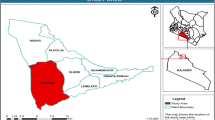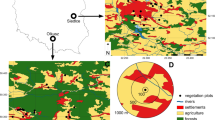Abstract
It is known that invasive dominants can significantly limit the species diversity of plant communities in microplots. However, it remains unclear whether they are capable of influencing the species diversity of large areas of vegetation. We considered this issue by the example of six areas of plant communities dominated by Solidago сanadensis located in habitats of different types (Belaya River valley, Western Caucasus, 190–210 m above sea level). Within each of them, biomass samples were taken from 25 plots of 0.25 m2, which were then disassembled by species and weighed. The results of the data analysis showed that (1) S. сanadensis significantly reduces the number of accompanying species in microplots of plant communities; however, the process of displacement of these species is predominantly nonselective (random); (2) areas of communities of different sizes with a high and low degree of dominance of S. сanadensis, containing a similar total stock of biomass of accompanying species, include, on average, a similar number of such species; and (3) the species similarity of plant communities located in habitats of different types does not depend on the degree of dominance of S. сanadensis in them. It was concluded that the size of the species pools of cenoses with high and low degrees of dominance of S. сanadensis is approximately the same. Accordingly, an increase in the participation of this species in communities can directly threaten other species only if the area of these communities is relatively small.


Similar content being viewed by others
REFERENCES
Akatov, V.V., Akatova, T.V., and Chefranov, S.G., Relationship between degree of dominance and species richness in grass communities with different productivities, Contemp. Probl. Ecol., 2018a, vol. 11, no. 4, pp. 355–365.
Akatov, V.V., Akatova, T.V., and Chefranov, S.G., The relationship of dominance and evenness with productivity and species richness in plant communities with different organization models, Russ. J. Ecol., 2018b, vol. 49, no. 4, pp. 296–305.
Akatov, V.V., Akatova, T.V., and Chefranov, S.G., Degree of dominance and species richness in plant communities with high and low intensity of interspecies competition, Biol. Bull. Rev., 2018c, vol. 8, no. 5, pp. 389–400.
Bartha, S., Szentes, Sz., Horváth, A., Házi, J., Zimmermann, Z., Molnár, Cs., Dancza, I., Margóczi, K., Pál, R., Purger, D., Schmidt, D., Óvári, M., Komoly, C., Sutyinszki, Zs., Szabó, G., Csathó, A.I., Juhász, M., Penksza, K., and Molnar, Zs., Impact of mid-successional dominant species on the diversity and progress of succession in regenerating temperate grasslands, Appl. Veg. Sci., 2014, vol. 17, no. 2, pp. 201–213.
Callaway, R.M. and Ridenour, W.M., Novel weapons: a biochemically based hypothesis for invasive success and the evolution of increased competitive ability, Front. Ecol. Environ., 2004, vol. 2, no. 8, pp. 433–436.
Chase, J.M., Powell, K.I., and Knight, T.M., ‘Bigger data’ on scale-dependent effects of invasive species on biodiversity cannot overcome confounded analyses: a comment on Stohlgren and Rejmánek (2014), Biol. Lett., 2015, vol. 10. https://doi.org/10.1098/rsbl.2015.0103
Csergő, A.M., Demeter, L., and Turkington, R., Declining diversity in abandoned grasslands of the Carpathian mountains: do dominant species matter?, PLoS One, 2013, vol. 8, no. 8.https://doi.org/10.1371/journal.pone.0073533
Gaertner, M., Breeyen, A.D., Hui, C., and Richardson, D.M., Impacts of alien plant invasions on species richness in Mediterranean-type ecosystems: a meta-analysis, Prog. Phys. Geogr., 2009, vol. 33, pp. 319–338.
Gross, K. and Cardinale, B.J., The functional consequences of random vs. ordered species extinctions, Ecol. Lett., 2005, vol. 8, pp. 409–418.
Hejda, M. and Pyšek, P., What is the impact of Impatiens glandulifera on species diversity of invaded riparian vegetation?, Biol. Conserv., 2006, vol. 132, pp. 143–152.
Hejda, M., Pyšek, P., and Jarošik, V., Impact of invasive plants on the species richness, diversity, and composition of invaded communities, J. Ecol., 2009, vol. 97, pp. 3393–3403.
Hejda, M., Štajerová, K., and Pyšek, P., Dominance has a biogeographical component: do plants tend to exert stronger impacts in their invaded rather than native range?, J. Biogeogr., 2017, vol. 44, pp. 18–27.
Hillebrand, H., Bennett, D.M., and Cadotte, M.W., Consequences of dominance: a review of evenness effects on local and regional ecosystem processes, Ecology, 2008, vol. 89, no. 6, pp. 1510–1520.
Houlahan, J.E. and Findlay, C.S., Effect of invasive plant species on temperate wetland plant diversity, Conserv. Biol., 2004, vol. 18, no. 4, pp. 1132–1138.
Liu, Y., Oduor, A.M.O., Zhang, Z., Manea, A., Tooth, I.M., Leishman, M.R., Xu, X., and Kleunen, M.V., Do invasive alien plants benefit more from global environmental change than native plants?, Global Change Biol., 2017, vol. 23, no. 8, pp. 3363–3370. https://doi.org/10.1111/gcb.13579
Meiners, S.J., Pickett, S.T.A., and Cadenasso, M.L., Effects of plant invasions on the species richness of abandoned agricultural land, Ecography, 2001, vol. 24, pp. 633–644.
Morozova, O.V. and Vinogradova, Yu.K., Solidago canadensis, Canada goldenrod, in Samye opasnye invazionnye vidy Rossii (Top-100) (The Most Dangerous Invasive Species in Russia (Top-100)), Dgebuadze, Yu.Yu., Petrosyan, V.G., and Khlyap, L.A., Eds., Moscow: Tov. Nauchn. Izd. KMK, 2018.
Powell, K.I., Chase, J.M., and Knight, T.M., A synthesis of plant invasion effects on biodiversity across spatial scales, Am. J. Bot., 2011, vol. 98, no. 3, pp. 539–548.
Powell, K.I., Chase, J.M., and Knight, T.M., Invasive plants have scale-dependent effects on diversity by altering species-area relationships, Science, 2013, vol. 339, pp. 316–318.
Pyšek, P. and Pyšek, M., Invasion by Heracleum mantegazzianum in different habitats in the Czech Republic, J. Veg. Sci., 1995, vol. 6, pp. 711–718.
Rejmánek, M. and Rosѐn, E., Cycles of heterogeneity during succession: A premature generalization?, Ecology, 1992, vol. 73, no. 6, pp. 2329–2331.
Rejmánek, M. and Simberloff, D., Origin matters, Environ. Conserv., 2017, vol. 44, no. 2, pp. 97–99.
Rejmánek, M. and Stohlgren, T.J., Scale-dependent impacts of invasive species: a reply to Chase et al., Biol. Lett., 2015, vol. 11. https://doi.org/10.1098/rsbl.2015.0402
Rejmánek, M., Richardson, D.M., and Pyšek, P., Plant invasions and invasibility of plant communities, in Vegetation Ecology, van der Maarel, E. and Franklin, J., Eds., Chichester, UK: Wiley & Sons, Ltd., 2013, 2nd ed., pp. 387–424.
Richardson, D.M., Macdonald, I.A.W., and Forsyth, G.G., Reductions in plant species richness under stands of alien trees and shrubs in the fynbos biome, South Afr. For. J., 1989, vol. 149, pp. 1–8.
Richardson, D.M., Pyšek, P., Rejmánek, M., Barbour, M.G., Panetta, F.D., and West, C.J., Naturalization and invasion of alien plants: Concepts and definitions, Diversity Distrib., 2000, vol. 6, pp. 93–107.
Rijal, D.P., Alm, T., Inger, L.N., and Alsos, G., Giant invasive Heracleum persicum: Friend or foe of plant diversity?, Ecol. Evol., 2017, vol. 7, pp. 4936–4950.
Seabloom, E.W., Borer, E.T., Buckley, Y.M., et al., Plant species’ origin predicts dominance and response to nutrient enrichment and herbivores in global grasslands, Nat. Commun., 2015, vol. 6, pp. 1–8.
Solan, M., Cardinale, B.J., Downing, A.L., Engelhardt, K.A.M., Ruesink, J.L., and Srivastava, D.S., Extinction and ecosystem function in the marine benthos, Science, 2004, vol. 306, pp. 1177–1180.
Somodi, I., Virágh, K., and Podani, J., The effect of the expansion of the clonal grass Calamagrostis epigejos on the species turnover of a semi-arid grassland, Appl. Veg. Sci., 2008, vol. 11, pp. 187–194.
Srivastava, D.S. and Lawton, J.H., Why more productive sites have more species: An experimental test of theory using tree-hole communities, Am. Nat., 1998, vol. 152, pp. 510–529.
Standish, R.J., Robertson, A.W., and Williams, P.A., The impact of an invasive weed Tradescantia fluminensis on native forest regeneration, J. Appl. Ecol., 2001, vol. 38, pp. 1253–1263.
Stohlgren, T.J. and Rejmánek, M., No universal scale-dependent impacts of invasive species on native plant species richness, Biol. Lett., 2014, vol. 10. https://doi.org/10.1098/rsbl.2013.0939
Vinogradova, Yu.K., Maiorov, S.R., and Khorun, L.V., Chernaya kniga flory Srednei Rossii (Chuzherodnye vidy rastenii v ekosistemakh Srednei Rossii) (The Black Book of Flora of Central Russia (Alien Plant Species in Ecosystems of Central Russia)), Moscow: GEOS, 2009.
Vítková, M., Müllerová, J., Sádlo, J., Pergl, J., and Pyšek, P., Black locust (Robinia pseudoacacia) beloved and despised: a story of an invasive tree in Central Europe, For. Ecol. Manage., 2017, vol. 384, pp. 287–302.
Weber, E., Biological flora of Central Europe: Solidago altissima L., Flora (Switzerland), 2000, vol. 195, pp. 123–134.
Wright, D.H., Species-energy theory – an extension of species-area theory, Oikos, 1983, vol. 41, pp. 496–506.
Zernov, A.S., Flora Severo-Zapadnogo Kavkaza (Flora of the Northwest Caucasus), Moscow: Tov. Nauchn. Izd. KMK, 2006.
ACKNOWLEDGMENTS
We are grateful to Professor M. Rejmánek for the recommendation to pay attention to the role of dominants in limiting the species diversity in large areas of vegetation and for help in finding publications on this issue.
Funding
The paper presents the results of research carried out with the financial support of the Russian Foundation for Basic Research (grant nos. 16-04-00228 and 20-04-00364).
Author information
Authors and Affiliations
Corresponding author
Ethics declarations
The authors declare that they have no conflict of interest. This article does not contain any studies involving animals or human participants performed by any of the authors.
Rights and permissions
About this article
Cite this article
Akatov, V.V., Akatova, T.V. & Chefranov, S.G. Impact of Solidago canadensis L. on Species Diversity of Plant Communities at Different Spatial Scale. Russ J Biol Invasions 12, 1–10 (2021). https://doi.org/10.1134/S2075111721010021
Received:
Revised:
Accepted:
Published:
Issue Date:
DOI: https://doi.org/10.1134/S2075111721010021




